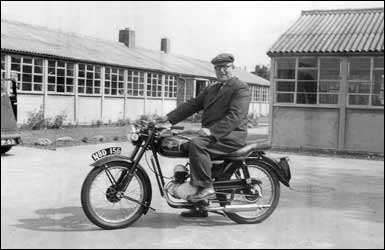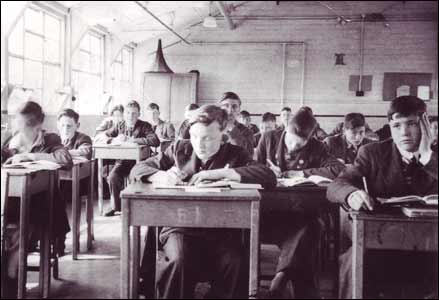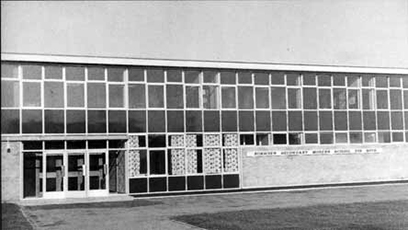|
|||||||
|
Secondary Education for Boys in Rushden (1949-1991)
|
|||||||
|
|||||||
|
Prior to 1947 all boys in the Rushden & Higham Ferrers sat a 11+ examination to decide if their secondary education would be at Wellingborough Grammar School, Wellingborough Technical School, Rushden Intermediate School or in some cases to remain at their Primary School until they left at the age of 14. Only a very small number, possibly 3 or 4 each year graduated to the Wellingborough Grammar School. The majority of pupils attended the Rushden Intermediate School, in the Hayway, which provided a co-education for boys and girls of secondary age. Rab Butler's 1944 Education Act had legislated for a new 3-tier system of Grammar, Technical Grammar and Secondary Modern and the raising of the school leaving age from 14 to 15 which came into being in Rushden in 1947, albeit in temporary buildings. Due to an extensive building programme throughout the country, brought about by the Education Act, it was in fact September 1949 before the buildings were ready in Rushden. They were prefabricated classrooms or H.O.R.S.A. huts (Hutted Operations for Raising the School-leaving Age) that were intended to be a temporary measure until a more permanent building could be erected. In fact they would be used for the next 24 years. On 6th September 1949 Tennyson Road County Modern School opened to provide a Secondary Modern Education for boys between the ages of 11 and 15 in Rushden and Higham Ferrers. The first Headmaster was Mr. S. "Sos" Howitt, who had transferred from the Intermediate school with a staff of 10 teachers. The number on roll totalled 207 pupils which consisted of all senior boys in Rushden & Higham Ferrers with the exception of those under the age of 13 from Newton Road School. The new school consisted of seven classrooms plus a woodwork room and a metalwork room arranged in four blocks. There was no Gymnasium so all games and P.E. lessons were conducted in the open air. Those pupils who stayed for school dinners were escorted to the school canteen in Portland Road until an arrangement was made with the adjacent Infant School to share their Hall. It is worth mentioning that although Tennyson Road was used in the name of the school it was never actually sited in that road. Note: access was from Wilson Road which was little more than a track
Due to the post WW II "baby boom" the number of pupils in the school gradually increased throughout the early 1950's to such an extent that by 1956 there were 343 pupils on roll, some 66% more than the original school was designed for. In the spring of 1956 work began on new school buildings that were intended to replace the "temporary" H.O.R.S.A. huts and accommodate the increased population of pupils. The Headmaster, Mr. L. J. Wilce, transferred to the John Lea School in Wellingborough and was succeeded by Mr. H. W. "Bert" Catlin who would serve as the school's Headmaster for the next 24 years. The new school buildings consisted of 9 classrooms, library, hall, kitchens and a gymnasium and were first occupied on the 30th April 1957, so ending the first phase of Tennyson Road Secondary Modern School's history. Practical subjects i.e. woodwork, metalwork etc, continued to be taught in the H.O.R.S.A. huts.
During the next few years the school's reputation continued to grow and was recognised as one of the leading Secondary Modern schools within the county. It became one of the few to offer examination courses to its pupils, starting with the Royal Society of Arts in the late 1950's and introducing G.C.E. courses in the 1960's. In 1972 the 11+ examination was discontinued and boys of all abilities within the two towns were introduced to a new system of education, Comprehensive. The name of the school was changed to Rushden Boys' Comprehensive School and more buildings were added to the site to accommodate yet another increase in the number on roll. Eventually the number of pupils would rise to nearly 1,200 and for the first time in its history the school had its own sixth form with ages in the school ranging from 11 to 18. Towards the end of the 1970's the name of the school changed yet again, this time to Rushden Boys' School. The late 70's also saw a serious problem of overcrowding in the school to such an extent that upwards of 10 mobile classrooms had to be brought in. Eventually it was decided that a third comprehensive school was required and a brand new one was erected in Higham Ferrers that was called The Ferrers School and opened its doors for the first time in 1980. This prompted a milestone in the history of Rushden Boys' School when its headmaster, Mr. H. W. Catiin, decided that it was an opportune time for him to retire. He had been employed at the school since its conception in 1949, a total of 31 years. He was held in great respect by his pupils and the local community and was known by one and all, affectionately, as "Bert". Mr. Catlin was replaced by Mr. D. Middlewood who brought a number of changes to the school, one being the idea that had been adopted by a number schools of naming the school after a local personality. It was decided that the school should be called The Pemberton School after the Pemberton family that had rived in Rushden Hall many years before. This would be the final time that the name was changed. During the late 80's the number of pupils in the town declined and it was decided by the Education Committee that one of the three Comprehensive schools should be closed. After much consultation and debate it was decided that The Pemberton School would close and its pupils would be amalgamated with those of the girls Chichele School to form a new school to be called The Rushden School. The Headteacher of The Pemberton School, Mr. D. Middlewood, resigned in 1990 and was replaced by his Deputy Headteacher, Mr. D. Rogers, who steered the school through its final days in 1991. Geoff Wiggins
Boys Education 1949-1991 Mainpage |
|||||||


